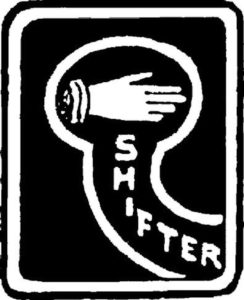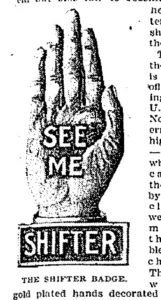 For a few months of 1922, a movement called the Shifters shook the United States of America. The group has uncertain origins, with newspapers across the United States reporting that the organisation began variously as the brainchild of a Dartmouth psychology student or as a fad started by high school students in either Boston or New York.
For a few months of 1922, a movement called the Shifters shook the United States of America. The group has uncertain origins, with newspapers across the United States reporting that the organisation began variously as the brainchild of a Dartmouth psychology student or as a fad started by high school students in either Boston or New York.
The Shifters – also known as the Flapper Bandits – were predominantly young women, although men were also accepted. As encapsulated by their motto – “get something for nothing” – the group aimed to recruit new members and make money. They had all the tempting trappings of a secret society: a strict dress code, a handshake, and secret code words. Shifters had a reputation for promiscuity. A Shifter might spend her evening rug-shaking and snugglepupping with her O.A.O. (shimmying and spooning with her one and only), but she wouldn’t be caught dead with a wallie or a goof. Paper clips were a common emblem of the group, and one newspaper claimed these were used to communicate secret messages. Two clips on the brim of your hat meant you were willing to kiss, while four on your hat and two on your coat lapel meant you didn’t have a date for the evening.
 The group spread furiously through a pyramid scheme of enrolment. A member would tempt an individual into joining, swear her in, and demand an initiation fee. The new Shifter was then free to find new victims and profit. The Shifters reportedly fleeced many young women out of their spending money, with Gertrude Robinson-Smith, president of the Working Girls’ Vacation Society (a savings fund for shop girls) vocally condemning the so-called Flapper Bandits. The Shifters had no official leader or strict structure, but spread like wildfire through their sign-up scheme. Being banned by schools and colleges only made the illicit society more exciting, and widespread media coverage helped fan the flames.
The group spread furiously through a pyramid scheme of enrolment. A member would tempt an individual into joining, swear her in, and demand an initiation fee. The new Shifter was then free to find new victims and profit. The Shifters reportedly fleeced many young women out of their spending money, with Gertrude Robinson-Smith, president of the Working Girls’ Vacation Society (a savings fund for shop girls) vocally condemning the so-called Flapper Bandits. The Shifters had no official leader or strict structure, but spread like wildfire through their sign-up scheme. Being banned by schools and colleges only made the illicit society more exciting, and widespread media coverage helped fan the flames.
Manufacturers were quick to cash in on the Shifters rising popularity and commercialise the rising trend. Jewellers and dressmakers sold ‘official’ Shifter merchandise. You could pick up Shifter pins and badges, and hats in your choice of a range of colours including ‘Shifter Red’ and ‘Shifter Green’.
Despite their merchandise and their media coverage, the Shifters died out as quickly as they arose and the society that had such a hold over America was over by the summer of 1922. Today we still know very little about the organisation, and theories abound as to whether the Shifters were a secret society, purely a pyramid scheme, or even a media invention aimed at promoting the Working Girls’ Vacation Society.
-Aoife Kurta
Junior Girl
Girl Museum Inc.
